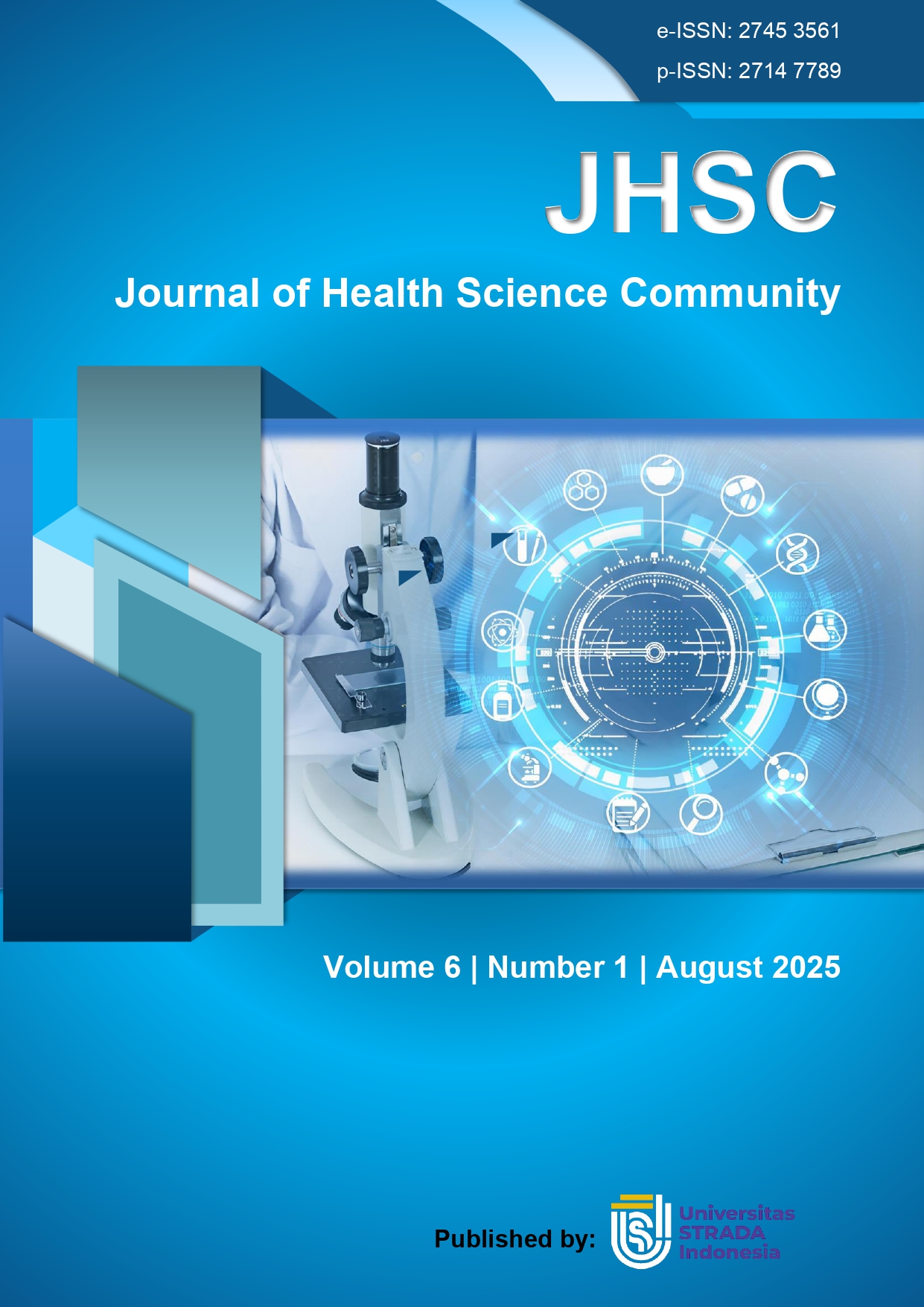The Effectiveness Of Education Using Vidio Is Determined Nutritional Knowledge In Mothers With Low Nutritional Children At At Sanur Health Center Nunukan District
DOI:
https://doi.org/10.30994/jhsc.v6i1.294Keywords:
Education, Nutrition, Toddlers, VideoAbstract
Toddlers who lack sufficient nutritional intake will most likely have a decreased immune system, making them susceptible to infectious diseases which can affect their appetite and absorption of nutrients, causing malnutrition. Toddlers who often experience infectious diseases and malnutrition will easily experience growth and development disorders at this age, which will affect the child's level of health and intelligence as well as productivity in the subsequent growth period. This research aims to determine the effectiveness of education using videos on nutritional knowledge in mothers of malnourished toddlers. This research is a quantitative research with a pre-experimental research design, one group pre-test post test with a cross sectional approach. The sample in this study was 72 mothers who had malnourished toddlers in the working area of the Sanur Health Center, Nunukan Regency, using a purposive sampling technique. The Wilcoxon statistical test was used to determine the effectiveness of education using videos on nutritional knowledge in malnourished mothers of toddlers.The results of research from 72 respondents, almost all respondents experienced an increase in knowledge, namely 41 respondents (55,9%) who had a sufficient level of knowledge and 31 respondents (43,1%) who had a good level of knowledge. .The results of bivariate analysis using the Wilcoxon test obtained a p value of 0.000 < 0.05, so the HI was accepted because there was the effectiveness of education using videos on nutritional knowledge in malnourished mothers of toddlers.It can be used as evaluation material to improve educational methods that are more interesting and it is hoped that it can increase knowledge about nutrition in toddlers.
References
Aisah1, S., & Suhartini Ismai. (2021). Edukasi Kesehatan Dengan Media Video Animasi: Scoping Review. Jurnal Perawat Indonesia, 5(1), 641–655. https://doi.org/10.32584/jpi.v5i1.926
Amelia. (2014). Kajian penanganan anak gizi buruk dan prospeknya. https://media.neliti.com/media/publications-test/223488-kajian-penanganan- anak-gizi-buruk-dan-pr-59e6e4c6.pdf
Anggraini, S. A., Siregar, S., & Dewi, R. (2020). Pengaruh Media Audio Visual Terhadap Tingkat Pengetahuan Dan Sikap Pada Ibu Hamil Tentang Pencegahan Stunting Di Desa Cinta Rakyat. Jurnal Ilmiah Kebidanan Imelda, 6(1), 26–31. https://doi.org/10.52943/jikebi.v6i1.379
Badan Pusat Statistik Provinsi Kalimantan Utara. (2021). Jumlah Bayi Lahir, Bayi Berat Badan Lahir Rendah (BBLR), dan Bergizi Kurang 2020-2022. Badan Pusat Statistik Provinsi Kalimantan Utara. https://kaltara.bps.go.id/indicator/30/106/1/jumlah-bayi-lahir-bayi-berat- badan-lahir-rendah-bblr-dan-bergizi-kurang.html
eka kurnia, & Rosad, S. dan. (2021). Sosio Antropologi Hubungan Sosio Antropologi Budaya, Gizi, Dan Kesehatan. Public Health, 5(3), 248–253.
Firmansyah, F. (2018). isi piringku. Kementrian Kesehatan Republik Indonesia. esmas.kemkes.go.id/portal/ppid
hartono. (2017). status gizi balita dan interaksinya (76th ed.). mediakom. Hovhannisyan. (2014). Public Health Nutr. Perkiraan Prevalensi Dan Prediktor
Kurang Gizi Pada Anak Usia 5-17 Bulan, 1046–1053.
Istiany, a, & Rusilanty. (2013). Gizi Terapan. PT Remaja Rosdakarya.
Kemenkes R1. (2019). Profil Kesehatan Indonesa 2019. In Kementrian Kesehatan Republik Indonesia. https://pusdatin.kemkes.go.id/resources/download/pusdatin/profil-kesehatan- indonesia/Profil-Kesehatan-indonesia-2019.pdf
magdalena. (2018). ENGARUH PENYULUHAN DENGAN METODE CERAMAH DAN AUDIO VISUAL TERHADAP TINGKAT PENGETAHUAN IBU HAMIL TENTANG SERIBU HARI PERTAMA KEHIDUPAN DI PUSKESMAS SIDOMULYO RAWAT INAP KOTA PEKANBARU. vol.7.
Mardalena, I., & Ida. (2017). Dasar-Dasar Ilmu Gizi dalam keperawatan.
Yogyakarta : PUSTAKA BARU PRESS.
Meohji. (2017). dasar dasar ilmu gizi. pustaka kemang.
Notoadmodjo soekidjo. (2014). promosi kesehatan dan perilaku kesehatan. PT. RINEKA CIPTA.
Notoatmodjo, S. (2016). Metode penelitian kesehatan. PT. RINEKA CIPTA. Nugrahaeni, D. E. (2018). Pencegahan Balita Gizi Kurang Melalui Penyuluhan
Media Lembar Balik Gizi. Amerta Nutrition, 2(1), 113. https://doi.org/10.20473/amnt.v2i1.2018.113-124
PMK no.2. (2020). standar Ampromometri Anak. https://yankes.kemkes.go.id/unduhan/fileunduhan_1660187306_961415.pdf
PMK, R. no. 4. (2014). pedoman Gizi seimbag (kementrian kesehatan). Pratiwi, H., Bahar, H., & Rasma. (2016). Wua-Wua Kota Kendari Tahun 2016.
Peningkatan Pengetahuan, Sikap, Dan Tindakan Ibu Dalam Upaya Pencegahan Gizi Buruk Pada Balita Melalui Metode Konseling Gizi Di Wilayah Kerja Puskesmas Wua-Wua Kota Kendari Tahun 2016, 1–8. http://betterwork.org/in-labourguide/wp-content/uploads/permenaker-08- 2010-alat_pelindung_diri.pdf
Pritasari, DAMAYANTI, D., & NUGRAHENI. (2017). GPIZI DALAM DAUR KEHIDUAN (2nd ed.). PPSDM KESEHATAN.
sopyah. (2020). engaruh Media Audio Visual terhadap Tingkat Pengetahuan dan Sikap pada Ibu Hamil tentang Pencegahan Stunting di Desa Cinta Rakyat. Jurnal Ilmiah Kebidanan Imelda, 6.
Sugiyono. (2015). METODE PENELITIAN KUANTITATIF, KUALITATIF, DAN
R&D. Alfabet CV.
susilawati. (2017). Efektifitas Promosi Media Leaflet dengan Media Audiovisual Tentang Pijat ayi Terhadap Pengetahuan Ibu Di Wilayah Kerja Puskesmas AMPLAS Tahun 2017. Skripsi. Poltekkes Kemenkes Medan. Skripsi.
Poltekkes Kemenkes Medan.
Toto Sudargo. (2022). budaya makan dalam perspektif kesehatan. gaja mada university press.


















